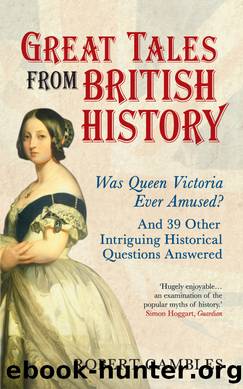Great Tales From British History by Robert Gambles

Author:Robert Gambles
Language: eng
Format: epub
Publisher: Amberley Publishing
Published: 2013-11-17T16:00:00+00:00
21
The Wars of the Roses:
Origin of the Name
Richard Plantagenet (later Duke of York):
Let him that is a true-born gentleman
And stands upon the honour of his birth,
If he supposes that I have pleaded truth,
From off this briar pluck a white rose with me.
Duke of Somerset (House of Lancaster):
Let him that is no coward or flatterer,
But dare maintain the party of the truth,
Pluck a red rose from off this thorn with me.
Shakespeare, Henry VI, Part I, Act 2, Scene IV
Shakespeareâs dramatic scene in the Temple Garden is a literary invention but such a powerful one that for generations it was accepted as the true origin of the term âThe Wars of the Rosesâ. It is true that the red rose had been chosen as his emblem by Edmund Crouchback, 1st Earl of Lancaster, in the thirteenth century, and also by John of Gaunt, 1st Duke of Lancaster, in the following century; it is also true that Edward IIIâs son, Edmund Langley, 1st Duke of York, had adopted the white rose at about the same time and that, in the initial stages of the wars, the protagonists were John of Gauntâs descendant, Henry VI, and Edmund Langleyâs descendant, Richard Plantagenet. However, Henry VI never used the red rose as his badge; and the white rose was just one of the many badges of Edward IV, while Richard III was always known by his badge of the white boar. It was only when the wars had ended that, for obvious political reasons, the Tudors put deliberate emphasis on the identification of the two rival houses with the two roses, and on the union that the accession of Henry Tudor, heir to Lancaster, and Elizabeth of York had achieved as husband and wife â and on the strength that this had brought to the monarchy and the stability it promised to the countryside after thirty years of warring factions and sporadic lawlessness.
The united roses first appeared in a pageant held to receive Henry and Elizabeth as they entered the city of York in 1486, but it was the birth of Prince Arthur on 19 September a few months later that the chroniclers hailed as the final reconciliation of the white rose with the red.1 The device of the Tudor Rose soon began to appear as an emblem in art and architecture and as a theme in music and literature. Stephen Hawes, court poet to Henry VII, assisted the propaganda in an address to the king:
Two tytles in one thou didest unyfye
When the red rose toke the white rose in maryage
and Henry VIIIâs poet laureate, John Skelton, used the occasion of Henryâs Coronation to continue the theme:
The rose both white and rede
In one rose now doth growe.
By 1592, when Shakespeare devised the scene in the Temple Garden, the concept of the conflict between Lancaster and York as a war between the red and the white rose had become a familiar part of the Tudor interpretation of history. In his important study of the Tudor Constitution (1583),
Download
This site does not store any files on its server. We only index and link to content provided by other sites. Please contact the content providers to delete copyright contents if any and email us, we'll remove relevant links or contents immediately.
Blood and Oil by Bradley Hope(1527)
Wandering in Strange Lands by Morgan Jerkins(1372)
Ambition and Desire: The Dangerous Life of Josephine Bonaparte by Kate Williams(1342)
Daniel Holmes: A Memoir From Malta's Prison: From a cage, on a rock, in a puddle... by Daniel Holmes(1291)
It Was All a Lie by Stuart Stevens;(1263)
Twelve Caesars by Mary Beard(1253)
The First Conspiracy by Brad Meltzer & Josh Mensch(1139)
What Really Happened: The Death of Hitler by Robert J. Hutchinson(1126)
London in the Twentieth Century by Jerry White(1110)
Time of the Magicians by Wolfram Eilenberger(1085)
Twilight of the Gods by Ian W. Toll(1083)
The Japanese by Christopher Harding(1081)
Cleopatra by Alberto Angela(1059)
A Woman by Sibilla Aleramo(1050)
Lenin: A Biography by Robert Service(1041)
The Devil You Know by Charles M. Blow(983)
Reading for Life by Philip Davis(969)
The Life of William Faulkner by Carl Rollyson(923)
1965--The Most Revolutionary Year in Music by Andrew Grant Jackson(919)
